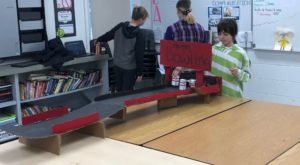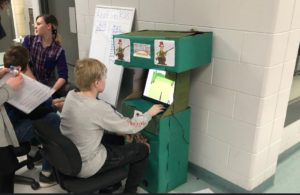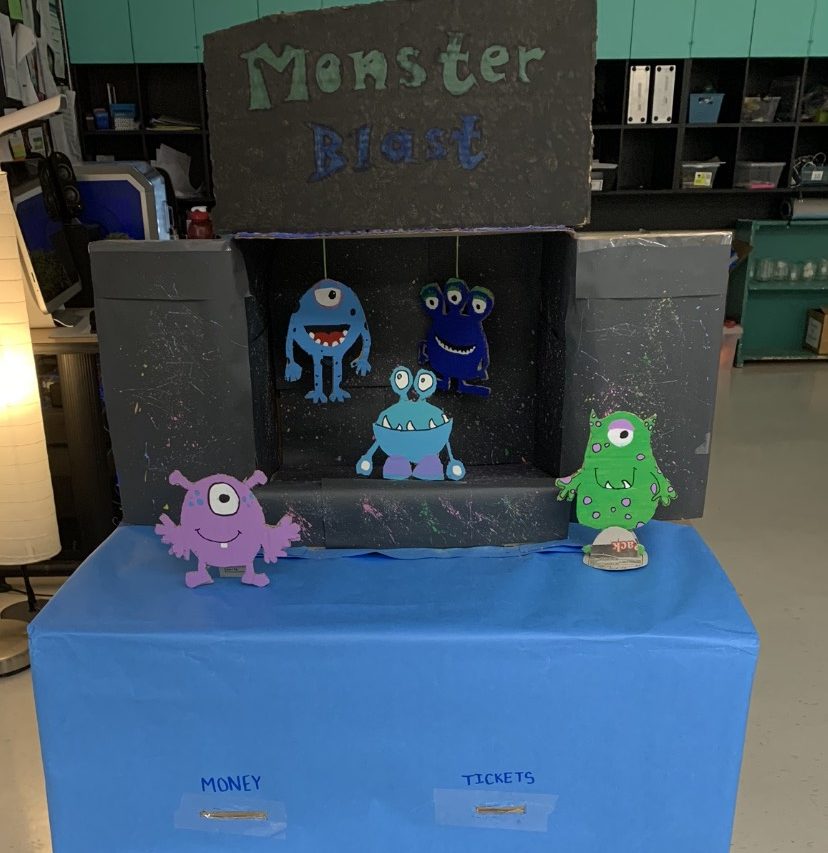Drawing inspiration from Caine, a young boy from East L.A., each year Grade 8 students at Green Valley School are challenged with a simple, yet equally difficult design process challenge: design and build a fully functional arcade game, that is aesthetically pleasing and constructed entirely out of cardboard and minimal supplies.
Throughout this design challenge, students discover the importance of identifying goals and criteria, as well as being able to identify the creative constraints involved. Working collaboratively in groups, students begin by drawing inspiration from Caine’s Arcade to brainstorm potential arcade games and the components of an arcade game. From this initial brainstorm, the teacher and students co-create criteria for what their final design should include. Once the end goal criteria is set, students are then provided with the constraints of this challenge, which were:
- Use only cardboard and a limited supply of hot glue sticks

- Finish within a set amount of time
- Adhere to specific size dimensions
All of these constraints took students by surprise, yet had them engaged in creative and critical thinking right from the outset. Once the constraints have been established, each group comes up with an initial design that meets the established criteria. Then, they create a plan and the steps to follow for their chosen design. Once the building has begun, students consistently reflect on the building process via FlipGrid video and written responses. These reflections are evidence of students’ critical thinking and collaboration abilities as they often encounter new problems which require creative solutions throughout this entire learning experience.
This design process challenge is an important learning experience because not only does it encompass all the design process learning outcomes from Cluster 0 in the science curriculum, but it also allows for so many extension activities. For example, students built empathy when they discussed hardships Caine had to overcome and his perseverance when creating his arcade. There were conversations about the environmental impact of the chosen material and how it would be properly disposed. Furthermore, all Grade 8 students celebrated the completion of their design challenge by hosting an arcade for their families and other students in the school. Parents and students had conversations with the Grade 8s about their games and provided them with feedback on their designs.
Students were constantly immersed in the design process via the split screen approach – working on developing four targeted competencies – collaboration, critical thinking, character and citizenship, as well as working on developing their design process skills as a Grade 8 learner. The best part was, students were having FUN while furthering their understanding of the importance of the competencies and the design process in relation to everyday challenges and tasks. One student said, “This design challenge  was really fun but it was also hard. It was like every time my group and I would have something go right, two things would go wrong and we would have to figure out what to do next. It made me think about what engineers must go through all the time.” Another student said, “In the end we couldn’t get our game to work exactly how we wanted it to and complete all of the criteria. Next time, we can try to focus on making it look awesome and also making sure it works. We spent too much time making sure it looked nice that we weren’t able to complete the other half of the challenge.” Another student highlighted the importance of working together and that each of us bring something different to the table, “Without [student’s name] our game wouldn’t have been aesthetically pleasing AT ALL. I provided a lot of ideas about how to make the game but definitely don’t have the art skills. I showed my partner how to do the building and they tried to teach me about painting.” This design process challenge also allowed all students to feel successful within their group and each student was able to take ownership for a specific portion of their arcade game. Every student was responsible for taking their turn operating their game while hosting the arcade and each student was proud to show off and explain their game with family and other students.
was really fun but it was also hard. It was like every time my group and I would have something go right, two things would go wrong and we would have to figure out what to do next. It made me think about what engineers must go through all the time.” Another student said, “In the end we couldn’t get our game to work exactly how we wanted it to and complete all of the criteria. Next time, we can try to focus on making it look awesome and also making sure it works. We spent too much time making sure it looked nice that we weren’t able to complete the other half of the challenge.” Another student highlighted the importance of working together and that each of us bring something different to the table, “Without [student’s name] our game wouldn’t have been aesthetically pleasing AT ALL. I provided a lot of ideas about how to make the game but definitely don’t have the art skills. I showed my partner how to do the building and they tried to teach me about painting.” This design process challenge also allowed all students to feel successful within their group and each student was able to take ownership for a specific portion of their arcade game. Every student was responsible for taking their turn operating their game while hosting the arcade and each student was proud to show off and explain their game with family and other students.
Here is what Malorie Fisher, these students’ teacher, had to say about this year’s arcade design challenge:
“Having completed this design challenge for four years now, it is still surprising to me how different this challenge is each year. Not only do the extension discussion questions/topics change based on the group of students I am teaching, the actual arcade games that are created change and vary each year. I have also always left how we celebrate our learning and accomplishments up to the students to plan and facilitate. I am always curious to see what each unique bunch of students come up with. When I began this design challenge as a homeroom teacher, my class hosted an arcade for other students to visit, via a donation, and ended up raising money to donate to our school’s annual coin drive. Another year my teaching partner and I collaborated on this project, students from different Grade 8 classes worked together across classes. With the aid of digital tools, students were able co-create commercials to advertise their games to the other students at Green Valley School. Last year, in an effort to build community, a Grade 8 class partnered with a Grade 5 class and worked on this challenge together. These students chose to celebrate by spending time together playing arcade games. As previously stated, this year we took yet another approach and hosted an arcade for the community. Parents, as well as grade 5 – 7 students, were invited to try out the games and provide feedback for the designers. It never ceases to amaze me the ideas our students have as well as the ideas they have about how they want to share/showcase their learning.

I highly recommend highlighting Caine’s perseverance in his arcade design to inspire your students to accept and excel in this design process challenge. Caine’s arcade makes for a wonderful provocation, that can lead to many rich classroom discussions and various design challenges.
As an unnamed legend once said, sometimes, “You need to take chances and make mistakes for real learning to happen.” I would add “get messy” because I guarantee that if you try this challenge, students will take chances, make many mistakes and it’ll be a little messy… but will be full of so many rich learning experiences!”
Written in collaboration with Malorie Fisher, Grade 8 Math/Science, Green Valley School
